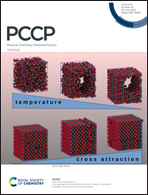Microwave spectra of dinitrotoluene isomers: a new step towards the detection of explosive vapors†
Abstract
The spectroscopic characterization of explosive taggants used for TNT detection is a research topic of growing interest. We present a gas-phase rotational spectroscopic study of weakly volatile dinitrotoluene (DNT) isomers. The pure rotational spectra of 2,4-DNT and 2,6-DNT were recorded in the microwave range (2–20 GHz) using a Fabry-Perot Fourier-transform microwave (FP-FTMW) spectrometer coupled to a pulsed supersonic jet. Rotational transitions are split by hyperfine quadrupole coupling at the two 14N nuclei leading to up to 9 hyperfine components. The spectral analysis was supported by quantum chemical calculations carried out at the B98/cc-pVTZ and MP2/cc-pVTZ levels of theory. Based on 2D potential energy surfaces at the B98/cc-pVTZ level of theory, the methyl group internal rotation barriers were calculated to be V3 = 515 cm−1 and 698 cm−1 for 2,4- and 2,6-DNT, respectively. Although no splitting due to internal rotation was observed for 2,6-DNT, several splittings were observed for 2,4-DNT. The microwave spectra of both species were fitted using a semi-rigid Hamiltonian accounting for the quadrupole coupling hyperfine structure. Based on the internal axis method (IAM), an additional analysis was performed to retrieve an accurate value of the rotationless A–E tunneling splitting which could be extracted from the rotational dependence of the tunneling splitting. This yielded in the case of 2,4-DNT to an experimental value of 525 cm−1 for the barrier height V3 which agrees well with the DFT value. The coupled internal rotations of –CH3 and –NO2 are investigated in terms of 2-D surfaces, as already done in the case of 2-nitrotoluene [A. Roucou et al., Chem. Phys. Chem., 2020, 21, 2523–2538].

- This article is part of the themed collection: 2023 PCCP HOT Articles


 Please wait while we load your content...
Please wait while we load your content...